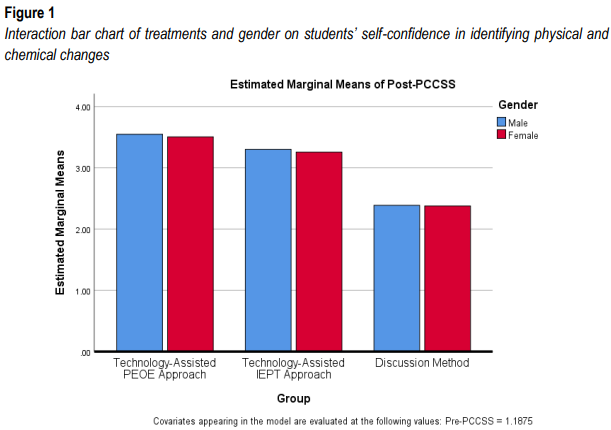Enhancing Students’ Self-Confidence and Critical Thinking Ability in Identifying Physical and Chemical Changes Using Technology-Assisted Constructivist Approaches
DOI:
https://doi.org/10.56855/jrsme.v4i1.1367Keywords:
Technology-assisted PEOE, Technology-assisted IEPT, Self-Confidence, Critical Thinking Ability, Identifying Physical and Chemical ChangesAbstract
Purpose: This study examined the effectiveness of technology-assisted constructivist approaches—namely, the Predict-Explain-Observe-Explain (PEOE) and Invitation-Exploration-Proposing Explanation-Taking Action (IEPT) models—in enhancing senior secondary students’ self-confidence and critical thinking in identifying physical and chemical changes. Methodology: A quasi-experimental, non-randomized pre-test, post-test control group design was employed. Instruments used were the Physical and Chemical Changes Self-Confidence Scale (PCCSS) and the Critical Thinking Ability Test (CTAT), both validated by subject experts. The study population consisted of 5,543 SS1 Chemistry students in Dekina Local Government Area, Kogi State, Nigeria. A sample of 228 students from six schools was selected through multi-stage sampling. Four research questions and four null hypotheses guided the study. Data were analyzed using mean, standard deviation, and Analysis of Covariance (ANCOVA). Findings: Results indicated statistically significant differences in students’ mean self-confidence and critical thinking scores across the PEOE, IEPT, and traditional discussion groups [F(2, 227) = 2325.074, p < .05; F(2, 227) = 209.004, p < .05]. However, no significant interaction effects were found between instructional method and gender on students’ self-confidence or critical thinking scores [F(2, 227) = .085, p > .05; F(2, 227) = .225, p > .05]. Significance: The study concludes that technology-assisted constructivist strategies significantly improve students’ cognitive and affective engagement in Chemistry. It is recommended that Chemistry educators integrate the PEOE and IEPT models to foster deeper understanding, self-confidence, and critical thinking in distinguishing between physical and chemical changes.
References
Agamber, S. T., & Ajayi, V. O. (2024). Is there any possibility of improving students’ confidence level in solving ecology-related problems using Science-based puzzles and spaced teaching approaches? A field Report. OJU Journal of Education, 21(1), 57-63.
Ahmed, W. (2022). Reciprocal relationships between math metacognitive awareness and math anxiety, learning and individ-ual differences. Retrieved on 12th January, 2025 from http://www.journals.elsevier.com/learning-and-individual-differences
Ajayi, E. E. (2023). Effects of PEDDA and IEPT instructional strategies on students’ attention, and academic performance in social studies in Benue State, Nigeria. Unpublished PhD. Thesis, Benue State University, Makurdi.
Ajayi, V. O., & Audu, C. T. (2023). Adaptation and implementation of spaced learning integrated with technology (SLIT) instruc-tional strategy and students’ academic performance in Chemistry. Journal of the International Centre for Science, Hu-manities and Education Research, 5(3), 52-64. https://doi.org/10.5281/zenodo.13344567
Ajayi, V. O. (2019). Effects of predict-explain-observe-explain and Vee heuristic strategies on students’ achievement, metacogni-tive awareness, and self-efficacy belief in organic chemistry in Ekiti State, Nigeria. Published PhD. Thesis, Benue State University, Makurdi. https://doi.org/10.2139/ssrn.3587073
Ajayi, V. O., Achimugu, L., & Audu, C. T. (2025). Ameliorating Students’ cognitive engagement and critical thinking in Chemistry: Testing the potency of practical-based and discussion-based approaches. British Journal of Multidisciplinary and Ad-vanced Studies, 6(1), 1-12. https://doi.org/10.37745/bjmas.2022.04216
Al-Hebaish, S. M. (2020). The correlation between general self-confidence and academic performance in the oral presentation course. Theory and Practice in Language Studies, 2(1), 60-65.
Bajar-Sales, P. A., Avilla, R. A., & Camacho, V. M. I. (2015). Predict-Explain-Observe-Explain (PEOE) approach: Tool in relat-ing metacognition to achievement in chemistry. Electronic Journal of Science Education, 19(7), 1-21.
Demirhan, E., & Besoluk, S. O. (2019). The change in academic performance and critical thinking disposition scores of pre-service teaching over time. Journal of Educational Science, 2(4), 403-412. https://doi.org/10.1016/j.ijcci.2023.100632
Foong, P. Y. (2019). Open-ended problems for higher thinking in mathematics. American Journal of Theoretical and Applied Statistics, 5(1), 1-4.
Ifagbemi, D. K. (2021). Effect of inquiry method on students’ interest in Computer. Journal of Science Teacher Today, 3(1), 17-20.
Mutai, D. K., Changeiywo, J. M., & Okere, M. I. O. (2014). Effects of Gowin’s Vee heuristic strategy on secondary school stu-dents’ conceptual understanding and metacognition in the topic of moments in physics, in Uasin Gishu County, Kenya. Journal of Education and Practice, 5(29), 193-205.
Nwafor, S. C., Ezeanya, M. C., Ameh, R. F., & Muoneke, N. M. (2024). Improving secondary school students’ achievement in Chemistry through interaction pattern approach. Journal of Digital Learning and Distance Education, 3(4), 1047-1056.
Samuel, K., Mari, J. S., & Alabi, A. (2023). Impart of process-based instruction on performance of students with different memory capacity in qualitative-analysis of secondary school chemistry. African Journal of Science Technology Mathe-matics Education, 9(1), 12-18.
Teerasong, S., Chantore, W., Ruenwongsa, P., & Nacapricha, D. (2016). Effect of predict-explain-observe-explain (PEOE) and lecture teaching strategies on achievement of elementary basic science students in Thailand. The International Journal of Learning, 18(4), 123-132.
WAEC. (2023). Chief Examiner’s reports for May/June West Africa Senior School Certificate Examination (WASSCE). WAEC.

Downloads
Published
How to Cite
Issue
Section
License
Copyright (c) 2025 Victor Oluwatosin Ajayi, Rachael Folake Ameh, Ayodeji Olorunmeye Alabi

This work is licensed under a Creative Commons Attribution 4.0 International License.










